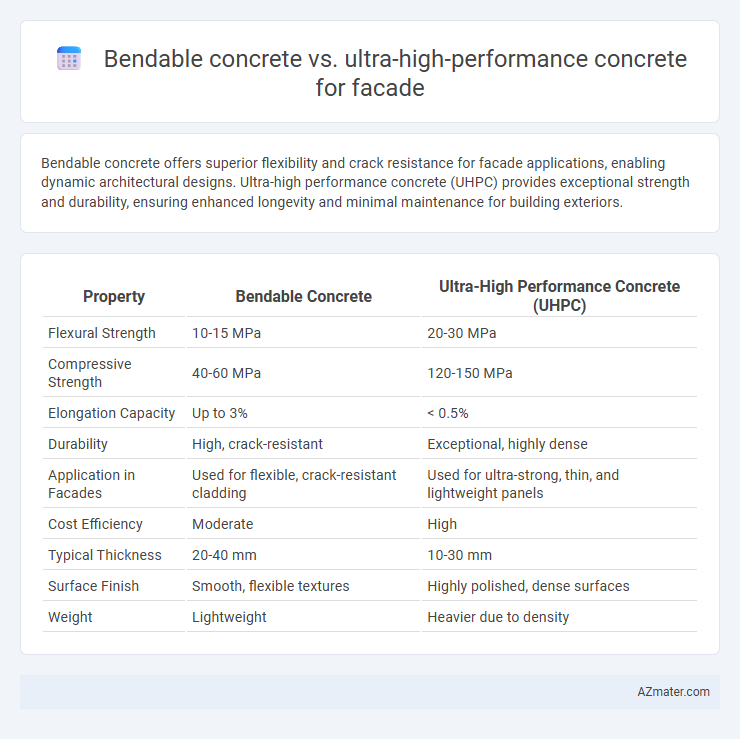Bendable concrete offers superior flexibility and crack resistance for facade applications, enabling dynamic architectural designs. Ultra-high performance concrete (UHPC) provides exceptional strength and durability, ensuring enhanced longevity and minimal maintenance for building exteriors.
Table of Comparison
| Property | Bendable Concrete | Ultra-High Performance Concrete (UHPC) |
|---|---|---|
| Flexural Strength | 10-15 MPa | 20-30 MPa |
| Compressive Strength | 40-60 MPa | 120-150 MPa |
| Elongation Capacity | Up to 3% | < 0.5% |
| Durability | High, crack-resistant | Exceptional, highly dense |
| Application in Facades | Used for flexible, crack-resistant cladding | Used for ultra-strong, thin, and lightweight panels |
| Cost Efficiency | Moderate | High |
| Typical Thickness | 20-40 mm | 10-30 mm |
| Surface Finish | Smooth, flexible textures | Highly polished, dense surfaces |
| Weight | Lightweight | Heavier due to density |
Introduction to Innovative Concrete Materials for Facades
Bendable concrete and ultra-high performance concrete (UHPC) represent cutting-edge innovations for facade applications, offering enhanced durability and design flexibility. Bendable concrete features engineered fibers that enable tensile flexibility and crack resistance, ideal for dynamic architectural forms. UHPC provides exceptional compressive strength and durability through a dense microstructure, making it suitable for thin, lightweight facade panels with superior weather resistance.
Overview of Bendable Concrete: Composition and Properties
Bendable concrete, also known as engineered cementitious composite (ECC), is composed of a cementitious matrix reinforced with short, tightly controlled polymer fibers that enhance its tensile strength and ductility. This innovative composite exhibits remarkable flexibility and crack resistance, enabling it to withstand bending stresses without significant damage, a crucial property for facade applications requiring durability and aesthetic longevity. Compared to ultra-high performance concrete (UHPC), bendable concrete offers superior strain capacity and energy absorption, making it ideal for dynamic architectural facades subject to structural movements and environmental stresses.
Ultra-High Performance Concrete (UHPC): Key Features and Advantages
Ultra-High Performance Concrete (UHPC) offers exceptional compressive strength exceeding 150 MPa and superior durability, making it ideal for long-lasting facade applications. Its ultra-dense microstructure provides enhanced resistance to environmental degradation, reducing maintenance costs and extending service life. Unlike bendable concrete, UHPC allows for intricate architectural detailing and sleek finishes while ensuring structural integrity and reduced material thickness.
Mechanical Performance: Flexibility vs. Strength
Bendable concrete offers superior flexibility and ductility, making it ideal for facades requiring crack resistance and deformation under stress, with strain capacities reaching up to 0.5%. Ultra-high performance concrete (UHPC) excels in compressive strength, often exceeding 150 MPa, providing exceptional load-bearing capacity and durability for structurally demanding facade applications. The choice between the two depends on whether flexibility to accommodate movement or maximum strength for structural integrity is prioritized in the facade design.
Durability and Weather Resistance in Facade Applications
Bendable concrete exhibits superior crack resistance and flexibility, enhancing facade durability by absorbing structural stresses and minimizing surface fractures under dynamic weather conditions. Ultra-high performance concrete (UHPC) offers exceptional compressive strength and a dense microstructure, significantly improving resistance to moisture ingress, freeze-thaw cycles, and chemical exposure in facade applications. Both materials enhance weather resistance, with UHPC providing longer lifespan under harsh environmental conditions, while bendable concrete reduces maintenance needs through its enhanced toughness and fatigue resistance.
Aesthetic Possibilities: Design Freedom and Surface Finishes
Bendable concrete offers exceptional design freedom with its flexibility, enabling architects to create smooth, curved facades and intricate shapes without traditional formwork constraints. Ultra-high performance concrete (UHPC) delivers superior surface finishes with fine textures and sharp details, enhancing aesthetic appeal through high precision and durability. Combining bendable concrete's formability with UHPC's refined surface qualities maximizes facade innovation in modern architectural design.
Installation Techniques and Practical Considerations
Bendable concrete offers enhanced flexibility and lighter weight, enabling easier manipulation and installation on curved or complex facade designs, reducing the need for extensive formwork or support structures. Ultra-high performance concrete (UHPC) demands precise mixing, curing, and specialized handling due to its dense microstructure and high strength, often requiring skilled labor and controlled environments to achieve optimal performance. Practical considerations favor bendable concrete for rapid, cost-effective installation on intricate facades, while UHPC suits applications needing superior durability and load-bearing capacity but involves higher installation complexity and costs.
Sustainability: Environmental Impact and Life Cycle
Bendable concrete, featuring enhanced ductility and crack resistance, reduces material usage and extends facade lifespan, contributing to lower environmental impact in the life cycle compared to conventional concretes. Ultra-high performance concrete (UHPC) offers superior strength and durability, minimizing maintenance and replacement needs, but its production involves higher energy consumption and carbon emissions due to specialized additives and fine powders. Life cycle assessments indicate bendable concrete balances sustainability with performance for facades, while UHPC suits applications demanding extreme durability despite a larger upfront environmental footprint.
Cost Analysis: Material, Labor, and Maintenance
Bendable concrete offers lower initial material costs compared to ultra-high performance concrete (UHPC) due to its simpler mix design and reduced fiber content, making it cost-effective for facade applications. Labor expenses for bendable concrete are generally less intensive since it requires standard curing and installation techniques, whereas UHPC demands specialized handling and skilled workforce, increasing labor costs. Maintenance costs favor bendable concrete as its crack resistance reduces repair frequency, while UHPC, although durable, may involve higher costs related to specific sealants or treatments over the facade's lifecycle.
Choosing the Right Concrete for Facade Projects
Bendable concrete offers superior flexibility and crack resistance, making it ideal for complex facade designs that require shaping and durability under stress. Ultra-high performance concrete (UHPC) provides exceptional strength and longevity, suitable for facades demanding high load-bearing capacity and minimal maintenance. Selecting between bendable concrete and UHPC depends on project requirements such as structural flexibility, aesthetic complexity, and environmental exposure.

Infographic: Bendable concrete vs Ultra-high performance concrete for Facade
 azmater.com
azmater.com